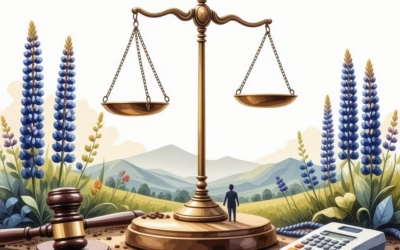Key Takeaways
- Government funding for farmers includes grants, loans, and subsidies that support agricultural operations and sustainability.
- Farmers can access USDA grants and state-specific funding tailored to local agricultural needs.
- Understanding eligibility criteria and the application process is crucial for securing government grants effectively.
- Programs like crop insurance and disaster assistance provide vital financial support during challenging times.
- In 2025, farmers can expect enhanced support programs focused on sustainability and innovation in agriculture.
- Exploring non-government grants and alternative funding sources can further assist farmers in securing necessary resources.
In the ever-evolving landscape of agriculture, understanding government funding for farmers is crucial for securing the financial support necessary to thrive. As we approach 2025, farmers are presented with a myriad of opportunities through various government grants and subsidies designed to bolster their operations. This article will delve into essential insights on how farmers can access these funds, including the types of grants available, eligibility criteria, and the application process. We will explore specific programs such as the $7,000 government grant for individuals, current subsidy statuses, and what the government is doing to support farmers in the coming year. Additionally, we will provide a comprehensive guide on securing funding for a farm, including resources for farmers in various regions, from Australia to India. Join us as we navigate the intricate world of government funding for farmers and uncover the vital resources available to ensure a prosperous future in agriculture.
How do farmers get money from the government?
Understanding Government Funding for Farmers
Farmers receive financial assistance from the government through various programs designed to support agricultural operations. The primary sources of funding include:
1. **Grants**: The U.S. Department of Agriculture (USDA) offers numerous grant programs aimed at specific agricultural needs, such as conservation, research, and rural development. These grants do not require repayment and can significantly aid farmers in improving their operations.
2. **Loans**: The Farm Service Agency (FSA) provides direct and guaranteed loans to family-sized farmers and ranchers who may struggle to secure financing from traditional banks. These loans can be utilized for various purposes, including:
– Purchasing land
– Acquiring livestock
– Buying equipment
– Obtaining feed, seed, and supplies
3. **Subsidies**: The government also offers subsidies for certain crops, which help stabilize farmers’ income and encourage production. These subsidies can be crucial during times of market volatility.
4. **Insurance Programs**: The USDA provides crop insurance programs that protect farmers against losses due to natural disasters or market fluctuations. This safety net is vital for maintaining financial stability.
5. **Technical Assistance**: In addition to financial support, the government offers technical assistance programs that provide farmers with resources and expertise to improve their agricultural practices and sustainability.
For more detailed information about these programs, farmers can visit the USDA website or consult local FSA offices.
Types of Government Grants and Subsidies Available
Government grants and subsidies for farmers vary widely, catering to different agricultural needs and regions. Here are some key types:
– **Federal Grants**: These include programs like the Grants.gov portal, which lists various federal funding opportunities available to farmers across the United States.
– **State-Specific Grants**: Many states offer their own grants tailored to local agricultural needs. For example, government grants for farmers in California and government grants for farmers in Australia provide targeted support.
– **Subsidy Programs**: Programs like the Farmers.gov site detail various subsidy options available for specific crops, helping farmers manage their production costs effectively.
– **Research and Development Grants**: These grants support innovative agricultural practices and sustainability efforts, often funded by the USDA and other agricultural research institutions.
Farmers looking to explore these funding options should regularly check for updates and new opportunities to ensure they are taking full advantage of available resources.
What is the $7,000 government grant for individuals?
The $7,000 government grant is primarily designed to assist low-income undergraduate students in covering tuition, fees, and other educational expenses. This grant is part of federal financial aid programs aimed at reducing the financial burden on students pursuing higher education.
Overview of Specific Grants for Farmers
In addition to educational grants, various specific grants are available for farmers, aimed at supporting agricultural development and sustainability. These government grants for farmers can help with everything from purchasing equipment to funding research initiatives. Understanding the types of grants available is crucial for farmers looking to enhance their operations.
- USDA Grants: The U.S. Department of Agriculture offers numerous grants aimed at improving agricultural practices and supporting rural development.
- State-Specific Grants: Many states provide their own funding opportunities, such as government grants for farmers in California and government grants for farmers in Ontario.
- Research and Development Grants: These grants support innovative farming techniques and sustainable practices, crucial for the future of agriculture.
Free Government Funding for Farmers: Eligibility and Application Process
Accessing free government funding for farmers involves understanding eligibility criteria and the application process. Here’s a breakdown:
- Eligibility Criteria:
- Farmers must demonstrate a viable farming operation.
- Applicants often need to provide financial records and a business plan.
- Specific grants may have additional requirements based on the type of funding.
- Application Process:
- Identify the appropriate grant program and review its requirements.
- Gather necessary documentation, including financial statements and project proposals.
- Submit the application through the designated platform, such as Grants.gov.
For more detailed guidance on navigating these processes, I recommend checking out resources available through the U.S. Department of Agriculture and Farmers.gov.
Does the US government still subsidize farmers?
Yes, the U.S. government continues to subsidize farmers through various programs aimed at stabilizing farm income, supporting agricultural production, and ensuring food security. These subsidies are primarily administered by the U.S. Department of Agriculture (USDA) and include several key components:
- Direct Payments: Farmers receive direct payments based on historical crop yields and acreage, providing a safety net during periods of low market prices.
- Crop Insurance: The government subsidizes crop insurance premiums, helping farmers manage risks associated with crop failures due to weather events or market fluctuations. According to the USDA, the Federal Crop Insurance program is crucial for protecting farmers’ incomes.
- Conservation Programs: Programs like the Conservation Reserve Program (CRP) incentivize farmers to convert environmentally sensitive land into conservation areas, promoting sustainable agricultural practices.
- Price Support Programs: The government sets price floors for certain commodities, ensuring that farmers receive a minimum price for their products, which helps stabilize their income.
- Disaster Assistance: In response to natural disasters, the USDA provides financial assistance to affected farmers, helping them recover and continue operations.
Recent trends indicate that these subsidies are evolving to address climate change and sustainability concerns, with an increasing focus on supporting practices that enhance environmental stewardship. For more detailed information on current agricultural subsidies, you can refer to the U.S. Department of Agriculture (USDA).
Current Status of Government Subsidies for Farmers
The landscape of government subsidies for farmers is continually changing, reflecting both economic conditions and policy shifts. In 2025, the focus remains on enhancing support for farmers through various federal funding initiatives. Key programs include:
- Farm Bill Programs: The Farm Bill outlines funding and policy directions for agricultural support, ensuring that farmers have access to necessary resources.
- Emergency Relief Programs: These programs provide immediate assistance to farmers affected by natural disasters, ensuring that they can recover swiftly and maintain their operations.
- Environmental Stewardship Initiatives: The government is increasingly investing in programs that promote sustainable farming practices, which not only benefit farmers but also contribute to environmental conservation.
For farmers looking to navigate these subsidies, understanding the specific programs available is crucial. Resources such as Grants.gov can provide insights into available funding options.
Federal Funding for Farmers: Key Programs and Initiatives
Federal funding for farmers encompasses a variety of programs designed to support agricultural production and ensure food security. Some of the most significant initiatives include:
- Commodity Credit Corporation (CCC): This program provides financial assistance to farmers through loans and payments, helping them manage cash flow and stabilize their operations.
- Rural Development Programs: These initiatives focus on improving the quality of life in rural areas, offering grants and loans for infrastructure projects that benefit farmers and their communities.
- Research and Development Grants: The USDA allocates funds for agricultural research, fostering innovation and helping farmers adopt new technologies and practices.
Farmers can explore these funding opportunities further by visiting the Farmers.gov website, which offers comprehensive resources and guidance on accessing federal funding.
What is the government doing to help farmers?
The government is actively supporting farmers through various initiatives aimed at enhancing agricultural productivity, sustainability, and economic viability. Key measures include:
- Financial Assistance Programs: The government provides direct financial aid through grants, loans, and subsidies to help farmers manage operational costs and invest in new technologies. Programs like the USDA’s Farm Service Agency offer low-interest loans and disaster relief funds.
- Research and Development: Investment in agricultural research is crucial. The government funds research institutions to develop innovative farming techniques, pest-resistant crops, and sustainable practices. The National Institute of Food and Agriculture (NIFA) plays a significant role in this area.
- Market Access and Trade Support: The government works to expand market access for farmers through trade agreements and export promotion initiatives. Programs like the Foreign Agricultural Service (FAS) help farmers reach international markets, enhancing their profitability.
- Sustainability Initiatives: To promote environmentally friendly practices, the government offers programs that encourage conservation and sustainable farming methods. The Conservation Reserve Program (CRP) incentivizes farmers to convert environmentally sensitive land into conservation areas.
- Education and Training: The government provides educational resources and training programs to help farmers adopt best practices and new technologies. Extension services, often provided through land-grant universities, offer workshops and one-on-one support.
- Insurance Programs: Crop insurance programs protect farmers against losses due to natural disasters or market fluctuations. The Federal Crop Insurance program helps mitigate risks, ensuring farmers can recover from adverse events.
These initiatives are designed to create a robust agricultural sector that can adapt to challenges such as climate change, market volatility, and evolving consumer demands. For more detailed information on government support for farmers, resources such as the USDA website and the Economic Research Service (ERS) provide comprehensive insights.
Government Support Programs for Farmers in 2025
In 2025, the government continues to enhance its support programs for farmers, focusing on sustainability and innovation. Notable programs include:
- Enhanced Grant Opportunities: The government is increasing funding for government grants for farmers aimed at promoting sustainable practices and technological advancements.
- Climate Resilience Initiatives: New programs are being introduced to help farmers adapt to climate change, including funding for drought-resistant crops and water conservation techniques.
- Support for Minority Farmers: There is a growing emphasis on providing government funding for black farmers and other minority groups to ensure equitable access to resources.
USDA Grants for New Farmers: Opportunities and Resources
The USDA offers a variety of grants specifically designed for new farmers, providing essential resources to help them establish and grow their operations. Key opportunities include:
- Beginning Farmer and Rancher Development Program: This program provides funding for education, training, and outreach to new farmers, ensuring they have the skills necessary to succeed.
- Value-Added Producer Grants: These grants assist farmers in developing new products or enhancing existing ones, allowing them to increase their market reach and profitability.
- Community Food Projects: This initiative supports projects that increase food security in low-income communities, providing funding for local farmers to connect with their communities.
For more information on these grants and how to apply, visit the USDA website for detailed guidelines and resources.
Are Farmers Getting a Payment in 2025?
As of 2025, farmers are expected to receive payments through various government programs aimed at supporting agricultural sustainability and economic stability. These payments may come from initiatives such as the Farm Bill, which is renewed approximately every five years and includes provisions for direct payments, crop insurance, and conservation programs.
Anticipated Government Payments for Farmers in 2025
Farmers can look forward to several types of government payments in 2025, which include:
- Direct Payments: Farmers may receive direct payments based on historical production levels and current market conditions. These payments are designed to provide financial stability during fluctuating market prices.
- Crop Insurance Subsidies: The government typically offers subsidies for crop insurance, helping farmers mitigate risks associated with natural disasters, pests, and market volatility. This support is crucial for maintaining farm viability.
- Conservation Programs: Programs like the Conservation Reserve Program (CRP) incentivize farmers to adopt environmentally friendly practices. Payments for enrolling land in conservation efforts can provide additional income.
- Disaster Assistance: In the event of natural disasters, farmers can access emergency relief funds. This assistance is vital for recovery and maintaining agricultural production.
- Sustainability Initiatives: With increasing emphasis on sustainable farming practices, farmers may also benefit from payments linked to environmental stewardship and carbon sequestration efforts.
For the most accurate and up-to-date information regarding specific payments and eligibility, farmers should consult resources such as the USDA website or local agricultural extension offices. These sources provide detailed guidance on available programs and application processes.
Government Grants for Farmers 2025: What to Expect
In addition to direct payments, various government grants for farmers are anticipated in 2025. These grants are designed to support specific projects, enhance farm productivity, and promote sustainable practices. Key areas of focus may include:
- Research and Development: Grants aimed at innovative agricultural practices and technologies that improve efficiency and sustainability.
- Infrastructure Improvements: Funding for upgrading facilities, irrigation systems, and equipment to enhance operational capabilities.
- Market Development: Grants to help farmers access new markets and improve their marketing strategies.
- Environmental Conservation: Financial support for projects that aim to protect natural resources and promote biodiversity.
Farmers should stay informed about the application processes and eligibility criteria for these government grants to maximize their funding opportunities in 2025.
How to Get Funding for a Farm?
Securing government funding for farmers can be a vital step in establishing or expanding a farming operation. Here are the key steps to navigate the funding landscape effectively:
Steps to Secure Government Grants for Farmers
To secure funding for a farm, consider the following comprehensive strategies:
- U.S. Department of Agriculture (USDA) Programs: The USDA offers various financial assistance programs through the Farm Service Agency (FSA). These include:
- Direct Loans: For beginning farmers and ranchers who cannot obtain financing from commercial sources.
- Guaranteed Loans: These loans are backed by the USDA, making it easier for farmers to secure funding from private lenders.
- Grants and Scholarships: Explore grant opportunities available through Grants.gov. Various programs support sustainable agriculture, research, and community development. Notable grants include:
- Sustainable Agriculture Research and Education (SARE): Funds innovative projects that advance sustainable farming practices.
- Beginning Farmer and Rancher Development Program (BFRDP): Provides grants to organizations that offer education, training, and technical assistance to new farmers.
- State and Local Programs: Many states have their own agricultural funding programs. Check with your state’s department of agriculture for specific grants, loans, and assistance programs tailored to local farmers.
- Private Sector Funding: Look into private grants and loans from agricultural organizations, non-profits, and foundations. Organizations like the Farm Credit System provide financing options specifically for farmers.
- Crowdfunding and Community Support: Platforms like Kickstarter or GoFundMe can be effective for raising funds from community members who support local agriculture.
- Business Plans and Financial Projections: Prepare a detailed business plan that outlines your farming goals, financial needs, and projected income. This will be crucial when applying for loans or grants.
- Networking and Partnerships: Engage with local agricultural extension offices, farming cooperatives, and industry associations. Networking can lead to funding opportunities and valuable resources.
Grants to Start a Farm with No Money: A Comprehensive Guide
Starting a farm with limited financial resources is challenging, but several grants and funding opportunities can help. Here’s a guide to finding grants specifically designed for farmers with little to no money:
- Free Government Grants for Farmers: Various federal and state programs offer free grants aimed at supporting new farmers. Research options like the free government grants for farmers to identify potential funding sources.
- Government Grants for Farmers 2025: Keep an eye on upcoming grants for 2025, as new funding opportunities are frequently announced. Programs like the government grants for farmers 2025 can provide essential financial support.
- Non-Government Grants for Farmers: Explore non-government grants for farmers as alternative funding sources. Many organizations offer grants that do not require repayment.
- Local Agricultural Programs: Investigate local initiatives that may provide funding or resources for new farmers. Many communities have programs designed to support local agriculture.
Additional Resources and Opportunities for Farmers
Farmers seeking financial assistance can explore various resources beyond traditional government funding. Understanding the landscape of available grants and subsidies is crucial for maximizing support. This section delves into government grants for farmers in different regions and alternative funding sources that can provide additional financial relief.
Government Grants for Farmers in Different Regions
Government funding for farmers varies significantly across regions, reflecting local agricultural needs and policies. Here’s a closer look at some key areas:
- Australia: The Australian government offers numerous government grants for farmers in Australia, focusing on sustainability and innovation in agriculture. Programs like the Department of Agriculture provide financial support for projects that enhance productivity and environmental stewardship.
- South Africa: In South Africa, government grants for farmers in South Africa are designed to support emerging farmers and promote food security. The Department of Agriculture, Forestry and Fisheries (DAFF) administers various funding initiatives aimed at improving agricultural practices.
- India: The Indian government provides government subsidies for farmers in India through programs like the Pradhan Mantri Kisan Samman Nidhi (PM-KISAN), which offers direct income support to farmers. Additionally, state-specific initiatives, such as the government subsidy for farmers in Maharashtra, enhance local agricultural productivity.
- Canada: Canadian farmers can access government grants for farmers in Canada through programs like the Canadian Agricultural Partnership, which supports innovation and sustainability in farming.
- Nigeria: In Nigeria, government grants for farmers in Nigeria are available through various federal and state initiatives aimed at boosting agricultural production and food security.
Non-Government Grants for Farmers: Exploring Alternative Funding Sources
In addition to government funding, farmers can benefit from non-government grants that provide essential financial support. These grants often focus on specific agricultural sectors or innovative practices:
- Private Foundations: Numerous private foundations offer grants to support sustainable farming practices, research, and community development. Organizations like the Rockefeller Foundation and the W.K. Kellogg Foundation provide funding opportunities tailored to agricultural initiatives.
- Non-Profit Organizations: Non-profit organizations often run grant programs aimed at supporting farmers, especially those from underrepresented communities. For instance, the Black Farmer Fund focuses on providing financial support to Black farmers in the U.S.
- Research Grants: Universities and research institutions frequently offer grants for agricultural research projects. These grants can help farmers implement innovative practices and improve crop yields.
By exploring both government and non-government funding options, farmers can secure the financial resources necessary to thrive in an ever-evolving agricultural landscape.




